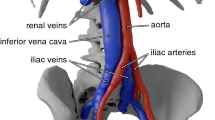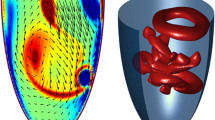Abstract
Intrinsic flow instability has recently been reported in the blood flow pathways of the surgically created total-cavopulmonary connection. Besides its contribution to the hydrodynamic power loss and hepatic blood mixing, this flow unsteadiness causes enormous challenges in its computational fluid dynamics (CFD) modeling. This paper investigates the applicability of hybrid unstructured meshing and solver options of a commercially available CFD package (FLUENT, ANSYS Inc., NH) to model such complex flows. Two patient-specific anatomies with radically different transient flow dynamics are studied both numerically and experimentally (via unsteady particle image velocimetry and flow visualization). A new unstructured hybrid mesh layout consisting of an internal core of hexahedral elements surrounded by transition layers of tetrahedral elements is employed to mesh the flow domain. The numerical simulations are carried out using the parallelized second-order accurate upwind scheme of FLUENT. The numerical validation is conducted in two stages: first, by comparing the overall flow structures and velocity magnitudes of the numerical and experimental flow fields, and then by comparing the spectral content at different points in the connection. The numerical approach showed good quantitative agreement with experiment, and total simulation time was well within a clinically relevant time-scale of our surgical planning application. It also further establishes the ability to conduct accurate numerical simulations using hybrid unstructured meshes, a format that is attractive if one ever wants to pursue automated flow analysis in a large number of complex (patient-specific) geometries.













Similar content being viewed by others
References
Baran, O. U. Control methodologies in unstructured hexahedral grid generation, PhD Thesis, Vrije Universteit Brussel, November 2005
Barton I. E. 1998 Comparison of simple- and piso-type algorithms for transient flows. Int. J. Numer. Methods Fluids 26:459–483
Bathe M., K. D. Kamm 1999 A fluid-structure interaction finite element analysis of pulsatile blood flow through a compliant stenotic artery. J. Biomech. Eng. 121(4):361–369
Cebral J. R., M. A. Castro, S. Appanaboyina, C. M. Putman, D. Millan, A. F. Frangi 2005 Efficient pipeline for image-based patient-specific analysis of cerebral aneurysm hemodynamics: technique and sensitivity. IEEE Trans. Med. Imaging. 24(4):457–467
Cebral J. R., M. A. Castro, J. E. Burgess, R. S. Pergolizzi, M. J. Sheridan, C. M. Putman 2005 Characterization of cerebral aneurysms for assessing risk of rupture by using patient-specific computational hemodynamics models. Am. J. Neuroradiol. 26(10):2550–2559
Dasi, L., K. Pekkan, K. Whitehead, M. Fogel, and A. P. Yoganathan. Hepatic blood flow distribution in the total cavopulmonary connection: patient-specific anatomical models. In: Proceedings of the ASME 2007 Summer Bioengineering Conference (SBC2007), Keystone Resort & Conference Center, Keystone, Colorado, June 20–24, 2007
DeGroff C., B. Birnbaum, R. Shandas, W. Orlando, J. Hertzberg 2005 Computational simulations of the total cavo-pulmonary connection: insights in optimizing numerical solutions. Med. Eng. Phys. 27(2):135–146
Di Martino E. S., G. Guadagni, A. Fumero, G. Ballerini, R. Spirito, P. Biglioli, A. Redaelli 2001 Fluid-structure interaction within realistic three-dimensional models of the aneurysmatic aorta as a guidance to assess the risk of rupture of the aneurysm. Med. Eng. Phys. 23(9):647–655
Dong S., G. M. Karniadakis, N. T. Karonis 2005 Cross-site computations on the Tera-Grid Comput. Sci. Eng. 7(5):14–23
Ensley A. E., P. Lynch, G. P. Chatzimavroudis, C. Lucas, S. Sharma, A. P. Yoganathan 1999 Toward designing the optimal total cavopulmonary connection: an in vitro study. Ann. Thorac. Surg. 68:1384–1390
Figueroa A. C., I. E. Vignon-Clementel, K. E. Jansen, T. J. R. Hughes, C. A. Taylor 2006 A coupled momentum method for modeling blood flow in three-dimensional deformable arteries. Comput. Methods Appl. Mech. Eng. 195:5685–5706
Fischer, P., F. Loth, S.-W. Lee, D. Smith, H. Tufo, and H. Bassiouny. Parallel simulation of high Reynolds number vascular flows. In: Proc. of Parallel CFD, 2005
Freitas C. J. 1995 Perspective: selected benchmarks from commercial CFD codes. J. Fluids Eng. 117(2):208–218
Hunter K. S., J. Craig, C. J. Lanning, S. Y. J. Chen, Y Zhang, R. Garg, D. D. Ivy, R. Shandas 2006 Simulations of congenital septal defect closure and reactivity testing in patient specific models of the pediatric pulmonary vasculature: a 3D numerical study with fluid-structure interaction. J. Biomech. Eng. 128(4):564–572
Khunatorn K., B. Shandas, C. DeGroff, S. Mahalingham 2003 Comparison of in vitro velocity measurements in a scaled total cavopulmonary connection with computational predictions. Ann. Biomed. Eng. 31(7):810–822
de Leval M. R. 2005 The Fontan circulation: a challenge to William Harvey? Nat. Clin. Pract. Cardiovasc. Med. 2(4):202–208
Masters J. C., M. Ketner, M. S. Bleiweis, M. Mill, A. Yoganathan, C. L. Lucas 2004 The effect of incorporating vessel compliance in a computational model of blood flow in a total cavopulmonary connection (TCPC) with caval centerline offset. J. Biomech. Eng. 126(6):709–713
Masters, J. C., M. Ketner, M. Mill, A. P. Yoganathan, and C. L. Lucas. Assessing the effect of compliance on the efficacy of the total cavopulmonary connection. J. Biomech. Eng. 2006 (in press)
Migliavacca F., R. Balossino, G. Pennati, G. Dubini, T. Y. Hsia, M. R. de Leval, E. L. Bove 2006 Multiscale modelling in biofluidynamics: application to reconstructive pediatric cardiac surgery. J Biomech. 39(6):1010–1020
Moyle K. R., L. Antiga, D. A. Steinman 2006 Inlet conditions for image-based CFD models of the carotid bifurcation: is it reasonable to assume fully developed flow? J. Biomech. Eng. 128(3):371–379
Pekkan K., D. Frakes, D. Zélicourt, C. W. Lucas, W. J. Parks, A. P. Yoganathan 2005 Coupling pediatric ventricle assist devices to the Fontan circulation; simulations with a lumped parameter model. ASAIO J. 51(5):618–628
Pekkan K., H. Kitajima, J. Forbess, M. Fogel, K. Kanter, J. M. Parks, S. Sharma, A. P. Yoganathan 2005 Total cavopulmonary connection flow with functional left pulmonary artery stenosis—fenestration and angioplasty in vitro. Circulation 112(21):3264–3271
Pekkan K., D. de Zélicourt, L. Ge, F. Sotiropoulos, D. Frakes, M. A. Fogel, A. P. Yoganathan 2005 Physics-driven CFD modeling of complex anatomical cardiovascular flows-a TCPC case study. Ann. Biomed. Eng. 33(3):284–300
Perot B. 2000 Conservation properties of unstructured staggered mesh schemes. J. Comput. Phys. 159(1):58–59
Tang B. T., C. P. Cheng, M. T. Draney, N. M. Wilson, P. S. Tsao, R. J. Herfkens, C. A. Taylor 2006 Abdominal aortic hemodynamics in young healthy adults at rest and during lower limb exercise: quantification using image-based computer modeling. Am. J. Physiol. Heart. Circ. Physiol. 291(2):H668–H676
Tezduyar. T. E., S. Sathe, T. Cragin, B. Nanna, B. S. Conklin, J. Pusewang, and M. Schwaab. Modelling of fluid–structure interactions with the space–time finite elements: arterial fluid mechanics. Int. J. Numer. Meth. Fluids 54(6–8):901–922, 2007
Whitehead, K. K., K. Pekkan, R. Doddasomayajula, H. D. Kitajima, K. S. Sundareswaran, A. P. Yoganathan, and M. A. Fogel. Extracardiac Fontan demonstrates lower power loss compared to intracardiac Fontan—a computational fluid dynamics study. Presented at the Annual Scientific Sessions of the American College of Cardiology, March 24–27, 2007
Yerneni, V., K. Pekkan, P. Nourparvar, D. de Zélicourt, J. Rossignac, L. Dasi, F. Sotirpoulos, and A. P. Yoganathan. Comparative CFD study of hemi-Fontan and Glenn anastomosis: idealized and anatomical models with free-form deformed variations. In: Proceedings of ASME-Bio2006 Summer Bioengineering Conference, Florida, June 21–25, 2006
Yue X., F. N. Hwang, R. Shandas, X. C. Cai 2004 Simulation of branching blood flows on parallel computers. Biomed. Sci. Instrum. 40:325–330
Zhang X., D. Schimdt, B. Perot 2002 Accuracy and conservation properties of a three-dimensional unstructured staggered mesh scheme for fluid dynamics. J. Comput. Phys. 175(2):764–791
de Zélicourt D., K. Pekkan, H. Kitajima, D. Frakes, A. P. Yoganathan 2005 Single-step stereolithography of complex anatomical models for optical flow measurements. J. Biomech. Eng. 127(1):204–207
de Zélicourt D., K. Pekkan, W. J. Parks, K. Kanter, M. Fogel, A. P. Yoganathan 2006 Flow study of an extra-cardiac connection with persistent left superior vena cava. J. Thorac. Cardiovasc. Surg. 31(4):785–791
Acknowledgments
This work was supported by a grant from the National Heart, Lung, and Blood Institute, HL67622. We also acknowledge Dr. Dave Frakes and Mr. Hiroumi Kitajima for processing the patient MRI datasets. The glycerin for the experimental work was provided by P&G, Cincinnati, OH.
Author information
Authors and Affiliations
Corresponding author
Rights and permissions
About this article
Cite this article
Wang, C., Pekkan, K., de Zélicourt, D. et al. Progress in the CFD Modeling of Flow Instabilities in Anatomical Total Cavopulmonary Connections. Ann Biomed Eng 35, 1840–1856 (2007). https://doi.org/10.1007/s10439-007-9356-0
Received:
Accepted:
Published:
Issue Date:
DOI: https://doi.org/10.1007/s10439-007-9356-0




